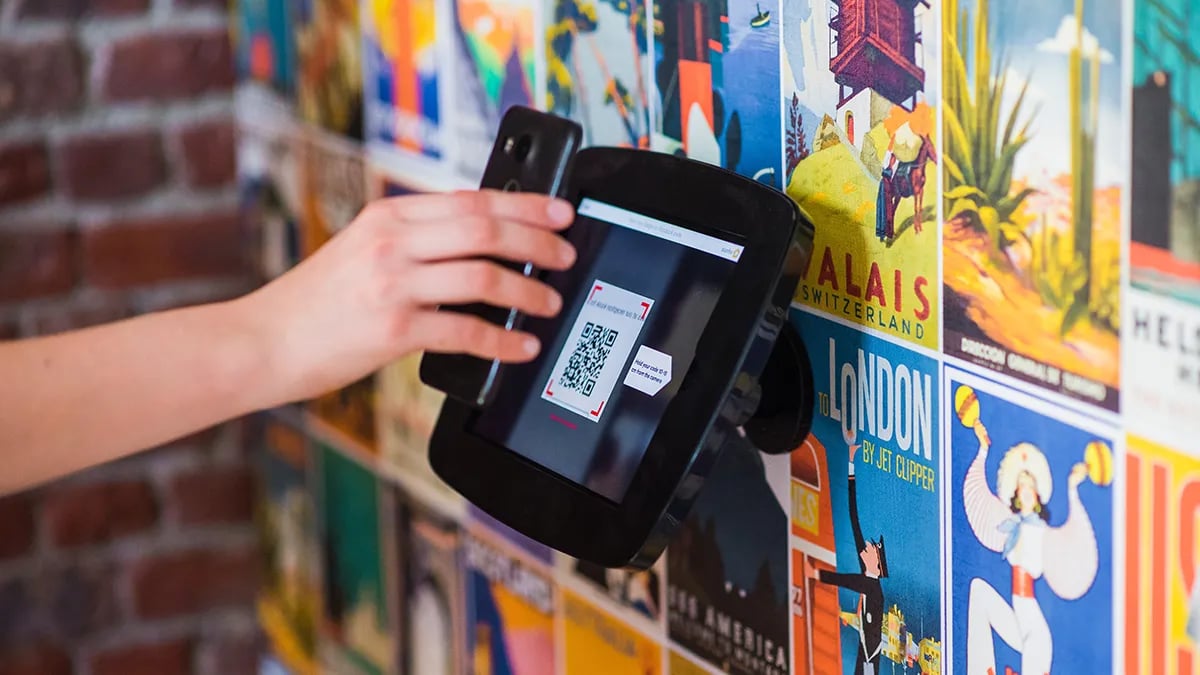- Products
- FacilityOS Platform
- Visitor Management
- Evacuation & Emergency Management
- PIAM & Access Control
- Mailroom Management
- Workforce Management
- Integrations
- Use Cases
- Process contractors and validate credentials
- Improve facility compliance to industry standards
- Improve speed of visitor check-in process
- Screen visitors or restrict access to my facility
- Automate my reception experience
- Improve and automate my facility evacuation process
- Manage facility security across multiple locations
- Industries
- Pricing
- Resources
- Company
How Touchless Visitor Management Improves Visitor Experience
May 17, 2022
Every so often, technological innovations transform the world in a way that has a lasting impact on our daily lives. In our globalized and connected society, these innovations occur faster than ever. The gap between the invention of paper and the printing press took over 1200 years. Because our globalized world has become so connected over the past century, world events have found a way of making these advances so much faster.
During World War Two the first electric computer, Colossus, was developed for Ally codebreakers and helped win the war. In less than 20 years, the first iteration of the internet was created to improve and secure military communications during the Cold War. By the 1990s, international adoption of the world wide web led to massive advances in a short period of time. Today computer technology and the internet touch every aspect of our daily lives. It's how we shop, keep in touch with friends and family and even host work-related meetings.
Now, world events are again shaping an innovation revolution with touchless sign-in technology. In response to the coronavirus pandemic, the ways that human beings spread germs and diseases are at the forefront of societal concern. Much like the internet, germs have been around for a long time; it just took a life-changing event to draw everyone's attention. And just like computers have continued on long beyond D-Day, contactless sign-in technology is here to stay.
The Emergence of Touchless Sign-In
One of the oldest forms of touchless technology has become so routine we hardly even notice it: automatic faucets. They're in nearly every airport bathroom, hospital, and restaurant. This touchless technology goes back to the 1950s. At the time, it was used mainly by medical facilities and restaurants to reduce the transfer of harmful bacteria. It wasn't until the 1980s that these amenities came into common use.
With the convenience and benefits of touchless technology and the emerging prevalence of mobile technology, it's only natural that the two would eventually meet. Enter the QR code.
The QR code — "QR" standing for "quick response" — was invented in 1994 by Masahiro Hara. In the beginning, it served very different purposes than it does today — such as the contactless sign-in system that Taiwan implemented to contain the coronavirus. The initial objective was to use high-speed component scanning to track cars during manufacturing. Soon, many industries began using it to track their merchandise as well.
In the early 2000s, QR codes got their first opportunity to enter the mainstream. Camera-equipped smartphones that could read the codes began to rise in popularity. In a few short years, the general population used QR codes for daily use. Easily accessing promoted websites, redeeming coupons, and even signing in to their flights at the airport. By June 2011, 14 million people (about twice the population of Arizona) were using their phones to scan QR codes.
Thus, touchless sign-in found a way to touch your life.

A Walk Through the Contactless Sign-In Process
The contactless sign-in experience isn't just about QR codes. Automatic doors, voice activation on your phone, and near-field communication — or NFC — are all forms of technology that you use without even touching a button. So, let's look at how you experience these processes.
Pretend you're going to a meeting in a building you've never visited. It could be an interview, a pitch meeting with a client, or anything for which you would have to enter an unfamiliar building. Now imagine everything your hands could touch between the front entrance and your exit from the building.
Right from the beginning, there are two possible points of contact. Of course, there's the door handle, but what if a security guard needs to buzz you in? You touch a button to contact the security guard. Then you put your mouth uncomfortably close to a public speaker to talk to the security guard. That's enough points of contact to, quite literally, make you sick.
With a smart visitor management system, you can provide any necessary information before approaching the front door with a touchless sign-in system. The automatic door confirms your information and opens by scanning a unique QR code on your phone. There's no need to sign in and touch a pen and clipboard that many others have already touched. With an adequately modernized elevator, you can even go straight to where you need to be without touching a button.
In the routine process of entering a building, contactless sign-in eliminates four contact points. Let's explore how touchless visitor management benefits you and your visitors.
How Visitors and Businesses Benefit from Contactless Visitor Processing
It may seem that contactless sign-in and other touchless technologies are only futuristic conveniences. However, the benefits go beyond the obvious. Touchless sign-in systems are becoming commonplace for good reasons.

Reduce the Spread of Germs Through Physical Contact
Automatic doors and touchless faucets were invented specifically to reduce the spread of germs. Of course, the world wasn't worried about a pandemic at the time. However, sterile environments needed ways to reduce the spread of germs.
Now that you've reeled through two years of a pandemic, it's time to look at how to prevent the next one.
Handwashing is the best way to stop the spread of germs, but what if your visitors never have to interact with those germs? Your lobby has some of the most used surfaces in your building. Touchless sign-in improves workplace safety measures and helps stop the spread of germs by enabling your visitors to keep their hands to themselves.
Touchless visitor management systems can include added features to automate visitor screening for COVID and other risks. Improve building, visitor, and employee safety with seamless integrations like vaccine passport scanning and thermal imaging.
The FeverCheck visitor temperature scanning integration uses a thermal camera to safeguard your workplace. The camera scans visitors to identify and alert potential health risks. All while protecting private health information in compliance with federal guidelines and requirements.
Allow Visitors to Use Their Smartphones with Email Invitations
Is your company planning an event that multiple visitors will attend? Typically, that involves a lot of contact during the sign-in process. But now, your visitors can use touchless sign-in systems using their own smartphones.
Additionally, their email invitation sends you a notification when they arrive. This means visitors don't have to wait; you can greet them right when they arrive at your office.
Speed Up the Check-In Process
This contactless technology doesn't just prevent the spread of germs; it also streamlines the sign-in process.
Usually, visitors have to wait in line until those in front of them have completed their check-in. Depending on how much information is needed, this can result in long lines and agitated visitors. An electronic visitor management system increases efficiency in your building.
With the ability to pre-fill the necessary information and agree to the terms of their visit, visitors can simply transfer this information to you right as they enter. This eliminates the holdup of a manual sign-in.
Online Pre-Registration
Have you ever seen TSA PreCheck travelers go through security? Nearly everything necessary for them to get from the front kiosk to their seat is taken care of before arriving at the airport. This is a major advantage of using a visitor pre-registration system. Enabling self-guided sign-in software within your company extends this convenience to your visitors.
Promote Employee Safety
It's not just your visitors you want to protect. Every company needs its employees to perform at their peak to grow. When your company welcomes multiple visitors per day, it's essential to do everything you can to ensure nothing that comes along with them can compromise your employees’ health.
Contactless visitor sign-in routines help prevent unwanted dangers from entering your business. They also help prevent the spread of germs among employees. Your employees work closely together, so keeping your operations as touchless as possible means employees will be less likely to spread their germs to others.
5 Signs Your Sign-In Process Needs a Change
The entire world is more sensitive to potential contact with diseases, and your office needs to adapt to this new normal. Contactless sign-in is not the future; it is the now. Here are some signs that it’s time for your company to embrace the change:
How to Use Contactless Access Systems in Your Building
Contactless systems already see regular use in workplace and facility management, whether for tracking products on the move or for signing in guests.
How can your company use touchless technology? Imagine everything you and others touch throughout the day and ask yourself whether your processes could be touchless. If you're having trouble getting started, here are a few ways touchless technology is already in use:
- Payment through NFC on smartphones
- Facial recognition for entrance access
- Unique QR codes for entrance and exit access and documentation
- Gesture recognition to activate technology
- NFC or QR codes to quickly transfer information
Optimize Your Entire Visitor Registration Process Today
Are you ready to modernize your sign-in process for visitors and employees? iLobby was voted by Tech Times as the top touchless sign-in system. We provide truly touchless technology by allowing your visitors to sign in using only their smartphones. We are the global leader in enterprise visitor management, supplying technology to reduce the risk that employees and visitors face through multiple entry points.
iLobby’s touchless sign-in can even incorporate a COVID-19 prescreening process that helps keep your office safe. It also allows you to monitor who is in your building, enhancing building and workplace safety.
Book your free demo for a safe and secure return to the workplace safely with iLobby's trusted visitor management solutions.
Ready to learn more? Touch up on the most impactful Features of Visitor Management Solutions.
Jeff Gladwish
Jeff Gladwish is the Chief Revenue Officer at iLobby where he spearheads the go-to-market strategy, driving the growth and adoption of our Facility and Visitor Management solutions. In 2023, Jeff was named one of Influitive’s Fearless 50 Customer-Led Marketing Leaders, an award that recognizes executives pushing the boundaries of customer marketing, advocacy, community, and loyalty.

